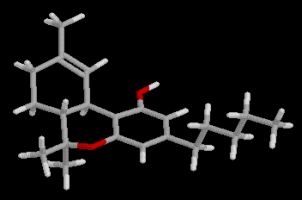MarijuanaThe principal active constituents in marijuana have been investigated since 1899, but the first pure-form isolation of tetrahydrocannabinol |
(THC)  |
Since its inception, the Chemistry Department at Mona has been involved in research in
natural products chemistry.
One of the most enduring projects in this area is that involving the chemistry of plant
species belonging to the croton genus.
In fact, five generations of postgraduate students have been involved in these studies,
which were initiated by Professor Wilfred R. Chan (recently retired from the UWI, St
Augustine, Trinidad) who was recently honoured for his invaluable contribution to
Chemistry at UWI and the region.
Pharmaceutical companies have recently shown a resurgence of interest in plant derived chemicals and over the last few years, thousands of plant extracts have been put through elaborate and costly biological screening programmes in the search for new compounds showing biological activity against viruses, bacteria, fungi and other microorganisms which are deadly to man.
I hope to be able to show some of this work including GC's, HPLC's and spectra, etc. soon.
Just to whet your appetite(?) What do you know about:
Aloe vera (sinkle bible, sempervivum, Aloe vulgaris) Bitter bush (Eupatorium villosum) Bitter wood (Picrasma exelsa) Cerasee Leaves (Mormodica charantia) Coralilla, Coralita (Antigonon leptopus) Crotons Dandelion (Stinking weed, piss-a-bed, Cassia occidentalis Dog blood (Ravina humilis) Fresh cut (Justicia pectoralis) John Charles (Hyptis verticillata) Love bush (Cuscuta americana) Marijuana (Cannabis sativa) Mistletoe (Oryctanthus occidentalis) search my heart (Rytidophyllum tomentosum) Shama lady (Mimosa pudica) Trumpet tree (Cecropia peltata)
The genus Croton belongs to the family Euphorbiaceae (which has about 700 species); a
family well known for producing compounds with diverse biological activity and elaborate
and interesting structures.
Members of the genus have been used in folk-medicine in Jamaica, North, Central and South
America- and in some countries in the Far East and Africa.
A number of Croton species have been investigated chemically yielding a variety of
interesting compounds, mainly alkaloids and terpenoids.
Examples of Jamaican Crotons that have been investigated include:
C. corylifolius C. nitens C. linearis C. humilis C. flavens C. wilsonii C. discolor C. lucidus
The first four have yielded a number of diterpenes, while the last four have yielded
some alkaloids.
C. corylifolius was one of the first members of the genus to be investigated. In that
study a novel goup of diterpenes with a hitherto unknown carbon skeleton was isolated and
characterised.
The new skeleton was named Crotofolane and since the original work which produced
compounds crotofolin A, B, C, D a fifth crotofolin has been isolated called crotofolin E.
The herbaceous plant, Justicia pectoralis (Fresh Cut) a member of the Acanthaceae family is used in folk-medicine for ther treatment of cuts and other ailments, including colic, consumption and flu. Preliminary studies on the plant juice and crude acetone extract revealed that the blood clotting time was significantly increased by these agents. The leaves and stems of the plant contain a coumarin as its major component. Flesh wounds created on Wistar rats and tested with the coumarin, extracted from the plant, showed less inflammatory process and enhanced wound- healing compared with control rats. This suggests that the use of this herbaceous plant influences the wound-healing process.
MarijuanaThe principal active constituents in marijuana have been investigated since 1899, but the first pure-form isolation of tetrahydrocannabinol |
(THC)  |
was only reported in 1964.
A Mass Spectrum of Delta-9-THC in JCAMP-DX format is available from here.
The cannabinoids are stored for the most part in the tiny, glandular hairs on the top
of the plant.
It is claimed that the average "joint", made from marijuana grown in the U.S.A.
contains about 2.5 to 5 mg of THC.
More information is available on: the biochemical
aspects of the effect of marijuana,
the CNS cannabinoid receptor
and again here .
THC was featured as the April 1996 Molecule of the Month (MOTM).
Images of plants and identification of constituents have been published by Michael Moore at the SouthWest School of Botanical Medicine
Return to links to the chemistry of other Jamaican items, including spices and fruit and vegetables.
Created Feb 1995. Last modified 30th June-98.
URL http://wwwchem.uwimona.edu.jm:1104/lectures/herbrem.html